Mark Sisson's Blog, page 320
November 4, 2013
Dear Mark: Grok’s Mobility, Too Much Walking, Fertile Eggs, and the Best Shoes for Babies
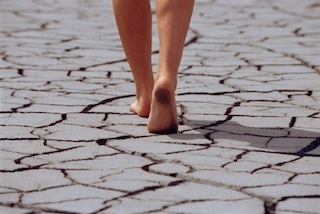 Hey folks, it’s time for another edition of Dear Mark. This time around we’ve got a four-parter. First up, I discuss why Grok probably didn’t need to foam roll with boulders or consult with a proto-Kstarr sporting a prominent brow ridge. Next, walking. It’s good, it’s vital, it’s low-stress, but is it possible to walk too much? Yes (but read on). After that, I delve into the extensive fertile egg literature. Er, maybe “extensive” isn’t quite accurate. Let’s go with “nearly non-existent.” And finally, I give the Primal pick for the best shoes for kids.
Hey folks, it’s time for another edition of Dear Mark. This time around we’ve got a four-parter. First up, I discuss why Grok probably didn’t need to foam roll with boulders or consult with a proto-Kstarr sporting a prominent brow ridge. Next, walking. It’s good, it’s vital, it’s low-stress, but is it possible to walk too much? Yes (but read on). After that, I delve into the extensive fertile egg literature. Er, maybe “extensive” isn’t quite accurate. Let’s go with “nearly non-existent.” And finally, I give the Primal pick for the best shoes for kids.
Let’s go:
Hi Mark,
Did Grok have to work on Mobility and listen to KStarr?
I’m 45 year old male who loves to lift heavy stuff (crossfit, strongman, oly lifting etc). I have not perfected my Grok lifestyle by any means but I was laying on the mats in my garage gym the other day, working mobility to prep for a workout, and thought to myself, did Grok have to do this? I mean I would be lost without working on mobility….
Was Grok always sore? Did he have to roll on lacrosse ball sized rocks to get ready for the days activity?
Thoughts/feedback as I wonder if it ever gets better?
Thanks,
Rob
Ha! Great question. Hilarious imagery.
I picked the brain of my buddy Angelo dela Cruz, of PrimalCon and VitaMoves fame, for his perspective and advice. In addition to being a great massage therapist, body worker, movement coach, and personal trainer, Angelo is one of those dudes who’s just “always on.” At the drop of a hat and without any real warmup, he’ll do a backflip, deadlift twice his bodyweight, or scale a building – because he’s always peppering his day with movement to stay limber. Anyway, here’s what he had to say:
We’ve created the need for mobility work, just as we have created the need for learning how to run barefoot or sit, stand, or walk with good posture. For most of us, our modern lifestyles don’t engage our muscles, connective tissue, & joints to a diverse set of movements that encourage a great level of mobility (or movement capability).
Chronic tightness and decreased ranges of motion could be regarded as deficits of the body. Whatever has happened to your body up to now has contributed to a “negative balance” in your mobility account. You can imagine mobility work as a type of investment. The more things you do that make your body feel tight on a consistent basis (activities, nutrition, emotional states), the more mobility work that your body may require to balance out or “get in the black”.
Will you always need to foam roll and do mobility work? You can think of that question to be similar to “Will I always need to brush and floss my teeth?”
As long as you’re alive and want good hygiene on the inside, movement will always play an important role in a human’s ability to enjoy life. However, if you don’t like foam rolling, I’d suggest finding more enjoyable ways to gain mobility and ways that you can get more bang for your buck. For me, that means breaking up the monotony of regular life with regular, easy, yet deliberate movement, or VitaMoves. I’ll start the day with a minute or two. Anytime I start feeling “stiff,” or realize I haven’t done anything in awhile or have been sitting for too long, I’ll get up and move. Most times, I devote a minute or two, so it doesn’t feel like work, but as a result I’m always ready to work out, lift, run, jump, or play without much warming up.
Like Angelo’s, Grok’s mobility account was in very good standing. A lifetime of good credit. Yours may not be, because you can’t (and haven’t been able to) spend your entire day moving around like a hunter-gatherer, rarely sitting (and never sitting in a chair with a keyboard in front of you), and your most comfortable position of repose being a full squat. You also exercise differently than Grok, who rarely engaged in repetitive motions for reps and sets. Ancient hunter-gatherers weren’t really setting aside 45 minutes out of the day to cram in 3×5 deadlifts or Tabata clean and jerks. Even if you use perfect technique, your tissues need more recovery after tons of reps simply because of the repetitive stress being applied to them.
All that said, informal systems of movement therapy have likely always been around. Early humans had the same brains as we do. They touched each other, they gave back rubs to loved ones, they figured out that having your thighs rubbed after a tough hunt helped recovery the next day and felt really good. Neanderthals were treating bone fractures and wounds and amputating limbs at least 130000 years ago, and it’s likely other early humans had at least rudimentary systems of medicine and “physical therapy.” They certainly used medicinal herbs. It’s not as if we just gave up and died en masse at the slightest hint of an injury or illness before modern medicine arose.
For the most part, though, I think formal mobility work is the product of and a reaction to a society that promotes and enables poor movement. It’s also kind of necessary if you’re going to work eight hours a day and then go to the gym. It can be annoying, but five minutes a day of movement work is way easier than dealing with a torn meniscus.
Is there such a thing as too much walking? After reading your article about not burning more than 4,000 calories per week through exercise, I’m starting to wonder. I bought a Fitbit in December and started walking A LOT. I’m averaging around 60 miles per week of walking. According to Fitbit, I’m burning about 26,000 calories per week. A sedentary person of my age/height/weight/sex burns 19,000 calories a week, giving me a differential of 7,000 per week. I’ve also noticed I’ve been losing muscle mass the last five months according to my Fitbit Aria scale. Thanks!
Jake
Yeah, there’s such a thing as too much of anything, I’d say. 60 miles a week is almost ten miles a day. Even if walking is “easy slow movement,” you’re still burning a lot of calories. 7000? Maybe, those devices aren’t super precise. It’s a good general barometer, though. Plus, if you’re walking upwards of 7, 8 miles each day, you’re sitting at a chronic daily calorie deficit. Calorie deficits work better in a fractal pattern, with a couple days of deficits followed by a day of maintenance or even surplus. That’s the basis for my recommendation of an occasional hypercaloric carb refeed; it helps restore lagging leptin levels and can increase metabolism.
The lost muscle mass is a definite red flag signaling that something needs changing.
Are you doing any strength training? Even on a caloric deficit, strength training is essential for maintaining lean mass. You’re not going to gain much of anything, but by lifting heavy things you’ll be sending the message to your body that you “need the guns” and they will be spared. If you’re not using them, they’ll get discarded because, well, you obviously don’t need all these stored amino acids that your liver would be happy to convert into glucose. Plenty of studies show that resistance training on a caloric deficit will retain lean mass, particularly with sufficient protein in the diet.
Cut the walking by nearly half and throw in a couple days of strength training. Bodyweight, barbells, machines, whatever. Just start stressing those muscles so they stop disappearing. You might eat more, and that’s normal because resistance training tends to increase appetite. You probably won’t lose weight as quickly, but only because you’ll be maintaining or increasing muscle. Body fat will drop, which is what you want.
Good luck.
Is there any advantage to buying fertile eggs? My health food store just started carrying them, and I wonder if I should indulge, or skip and stay with my pastured eggs?
Wenchypoo
Raw fertile eggs were one of the classic bodybuilding foods, along with raw milk and beef liver. Those last two have been vindicated by science – raw milk is obviously great for muscle growth, but it’s also rich with beneficial fat (if grass-fed, particularly), fat soluble vitamins, and helpful immunological components; liver is dense with practically every important nutrient, including vitamin A and cholesterol, which we need for testosterone production – but what about fertile eggs? Bodybuilding legend Vince Gironda said that eating 36 fertile eggs a day was comparable to using Dianabol (a steroid). There may be something to it.
Several online sources claim that fertile eggs contain a myostatin inhibitor called follistatin. Yeah, it’s a page on a supplement site hawking fertile egg extract, but the cited studies seem to confirm that fertile eggs (in sufficient amounts) can downregulate myostatin. Myostatin slows down muscle growth, so when you inhibit myostatin, you increase muscle growth. Animals with genetic myostatin deficiencies are ridiculously proportioned slabs of pure muscle, like the double-muscled cattle or the bulley whippet.
I’d stick with the pastured eggs, personally, unless your main focus is muscle gain. Might be a fun experiment to try. A dozen fertile eggs a day coupled with intense strength training? Anyone up for it? Anyone already try it?
Mark! MARK! I request, nay, demand a list of minimalist shoes for children! My five month-old will be learning to walk soon, and you can bet he’ll be in the softest shoes I can find.
Perfect timing for this one. We’ve got a couple workers around the office with either babies or incoming babies who are neck deep in this topic.
Vibram makes Fivefingers for toddlers and older kids (good luck getting a baby’s wriggling toes into a pair of those!).
Vivo Barefoot has a kids section, though I think it’s just for older kids and not babies.
And a UK retailer called Happy Little Soles sells only acceptably minimalist footwear for babies and kids. They’re all about “developing feet,” so you can use their product list to research other companies.
But the consensus choice around here is Bobux, a company out of New Zealand making soft, supple leather shoes for babies, toddlers, and other categories of youngster. In their “About” section, they explain how their goal was to “allow the feet to function properly and grow without restrictions.” That sounds extremely promising. The shoes are super flexible – you can practically roll it up and stick it in your shirt pocket if you’re so inclined – and they’re very light with a lot of ground feel.
Just in case anyone is on the fence with their kids and barefooting/minimalist shoe-wearing: a kid’s foot doesn’t stop maturing until around age 18. Particularly in the first several years, there’s a significant amount of cartilage rather than bone. Cartilage that’s “finding its way.” Cartilage that will take whatever shape (within reason; you couldn’t give your kid a three-toed chicken foot or anything) you impress on it. Cartilage that turns to bone. Plus, kids are establishing neural connections between their feet and brain using the sensory feedback they get from the ground, connections they’ll use as a foundation for their movement, balance, coordination, and athleticism for the rest of their lives. Putting them in thick, hard shoes removes that. Heck, even the American Academy of Pediatrics recommends a soft-soled, flexible shoe for the first year (though I’d say the first four to five years at least).
That’s it for today. Thanks for reading, everyone!
Get Your Omega-3s: Order Two Bottles of Primal Blueprint Fish Oil Capsules and Get An Additional Bottle Absolutely FREE

November 3, 2013
Weekend Link Love
 The Primal Blueprint Transformation Seminar is coming to Michigan next month. Come out and meet fellow Grok stars at this 2 1/2 hour event.
The Primal Blueprint Transformation Seminar is coming to Michigan next month. Come out and meet fellow Grok stars at this 2 1/2 hour event.
Research of the Week
Eating full-fat and full-fat fermented dairy makes for better cardiovascular biomarkers than eating low-fat dairy in overweight adults.
Did Neandertals actually eat daily salads full of medicinal herbs and wild vegetation, or were they eating the fermented stomach contents of their herbivorous prey?
Interesting Blog Posts
It’s possible to get inventive and come up with ways to stay active and energized while stuck in an airport (terminal to terminal sprint intervals, anyone?) on your own, but this post giving 12 examples of airports with health and fitness bents for travelers sure makes it easy.
Media, Schmedia
A (formerly) overweight Kentucky grandfather goes from walkers and canes to performing human flags on vertical poles. Pretty incredible story.
At Harvard later this month, Dr. Mat Lalonde and Allan Savory are giving a talk on how Primal eating and holistic grass-fed livestock management can quite possibly save the planet. If you’re in the area on November 21, go check it out.
Nothing like a big whopping serving of fear to keep the public from hearing an alternative, arguably more sensible position on a cherished pharmaceutical cash cow that could be hurting more people than it helps.
Everything Else
Part 2 of the Oz piece featuring Dr. Eades on cholesterol and heart disease – this time focusing on the overstated benefits and understated dangers of statins – has been released. Check it out here. This is the one the “experts” mentioned in the previous link were freaking out about, so you know it’s a good one.
You no longer have to spurn the entreaties from cookie-hawking Girl Scouts: they’ve gone gluten-free. Although please continue to ignore the overbearing Girl Scout parents in your office who try to guilt everyone into buying boxes of cookies.
Or, you could just use actual butter. Crazy, right?
Recipe Corner
In case you’re supplying the chow for a reenactment of the (perhaps embellished by the rosy hue of conventional history) original Thanksgiving dinner, here are 33 recipes for a paleo Thanksgiving.
This herring salad recipe leaves a lot to the imagination, but that’s part of the fun. Plus, we could all use more herring in our lives.
Time Capsule
One year ago (Nov 3 – Nov 9)
Hormesis: How Certain Kinds of Stress Can Actually Be Good for You – Earlier this week, we talked about making stress your friend by changing how you think about it. This post explains how stress can actually have a positive physiological effect, too.
Boxers or Briefs? – The eternal question is finally answered. We can all log off now.
Comment of the Week
Actually it would if you eat it instead of injecting it. Heroin was sold as an oral cough medicine for a long time with very few people getting addicted until someone had the idea of injecting the stuff. As I understand it, the slower onset and lower peak effect greatly limit the addictive potential.
I still agree that “everything in moderation” is bad as a general principle.
- I rather enjoyed this surprisingly informative response. Thank you.
Like This Blog Post? Dig Deeper with Primal Blueprint Books and Learn How You Can Reprogram Your Genes to Become Leaner, Stronger and Healthier

November 2, 2013
Filipino Beef Kaldereta
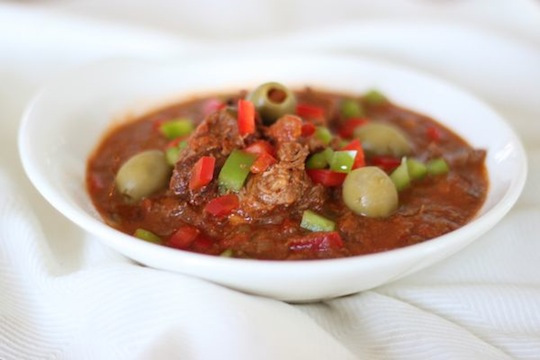 Kaldereta is a Filipino stew with flavors influenced by three centuries of Spanish colonization in the Philippines. Tomato-based and traditionally made with goat or beef, potatoes, green olives and peppers, it’s a filling, comforting dish.
Kaldereta is a Filipino stew with flavors influenced by three centuries of Spanish colonization in the Philippines. Tomato-based and traditionally made with goat or beef, potatoes, green olives and peppers, it’s a filling, comforting dish.
The really ingenious ingredient in Kaldereta is puréed chicken liver.
Stirred in at the end, chicken livers give the stew a thick, creamy texture and super-meaty flavor. This technique can be used with any of your favorite stew, chili or curry recipes. There are more sneaky ways to work offal into your meals, but this is arguably one the easiest and tastiest methods.
Liver is a nutrient-dense food, so you don’t need to eat all that much to get a beneficial dose of vitamins A and B, folic acid, iron, copper and CoQ10. Make a batch of Kaldereta, freeze individual servings to defrost for lunches, and you’ll be getting a little liver in your diet every week.
Servings: 6 to 8
Time in the Kitchen: 3 hours
Ingredients:
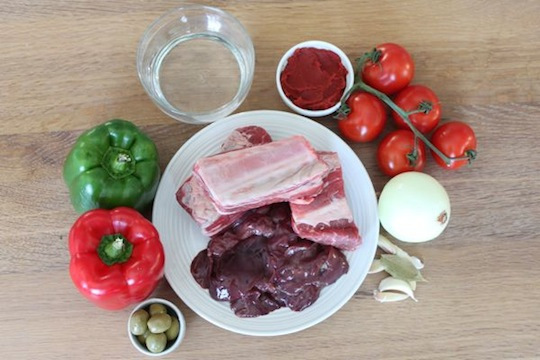
2 pounds beef (stew chunks or short ribs) (900 g)
1/2 pound chicken livers, trimmed of fat and membranes (230 g)
1 onion, finely chopped
6 cloves of garlic, finely chopped
1 to 2 red bell peppers, finely chopped
1 to 2 green bell peppers, finely chopped
1 teaspoon red pepper flakes (optional) (5 ml)
1/2 pounds tomatoes, chopped (230 g)
6 ounces tomato paste
2 1/2 cups water or beef stock (475 ml)
2 bay leaves
1/3 cup pitted green olives (50 g) (optional)
Instructions:
Season the meat generously with salt and pepper. Heat a thin layer of oil in a sauté pan over medium-high heat. Brown the beef, in batches if necessary. Set aside.
Season the chicken livers with salt and pepper. Add them to the pan. Cook, stirring often, until they are just barely cooked through and still pink inside.
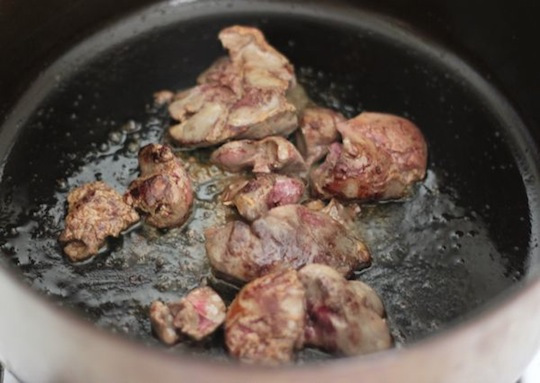
In a food processor, puree the chicken livers until very smooth. Set aside.
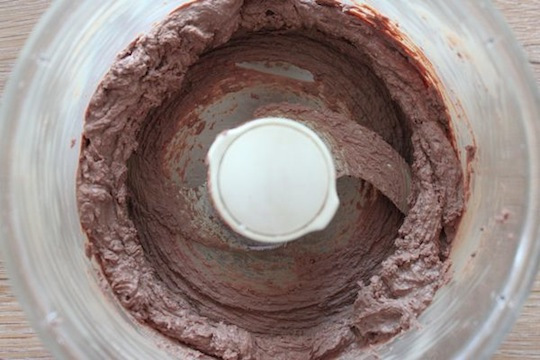
Add the onion, garlic and chopped bell peppers and red pepper flakes to the pan. Cook until the vegetables soften, 5 to 8 minutes.
Add the tomatoes and tomato paste. Sauté a few minutes more then add the water/stock, about 2 1/2 cups or enough to just cover the meat. Add the bay leaves.
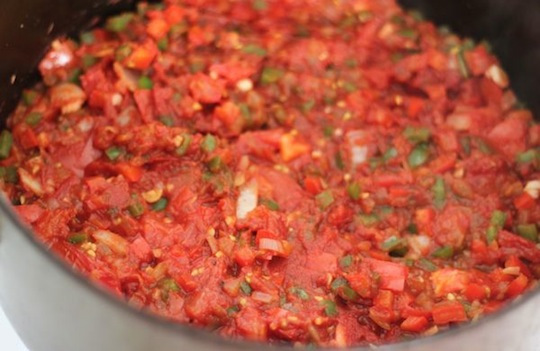
Bring to a boil. Lower the heat, cover and simmer for two hours or until the meat is fork tender. Stir occasionally during cooking. Add salt to taste.

Slowly stir the chicken liver purée into the Kaldereta until it blends in completely. Add the olives. Simmer 5 to 10 minutes before serving.

Not Sure What to Eat? Get the Primal Blueprint Meal Plan for Shopping Lists and Recipes Delivered Directly to Your Inbox Each Week

November 1, 2013
I Am Healed from the Inside Out!
It’s Friday, everyone! And that means another Primal Blueprint Real Life Story from a Mark’s Daily Apple reader. If you have your own success story and would like to share it with me and the Mark’s Daily Apple community please contact me here. I’ll continue to publish these each Friday as long as they keep coming in. Thank you for reading!
 Hi Mark!
Hi Mark!
It’s a privilege to write to you and I have been meaning to do so for months now.
I am a Registered Nurse and was taught the Standard American Diet (SAD), therefore, I taught my patients the same, “whole grains and brown rice are good for you!”
After my incredible Primal transformation, I started teaching the Primal lifestyle to my patients and have been passionate about teaching this lifestyle to everyone.
My story begins in early 2012 when my soon-to-be-husband, David, told me about an interesting podcast he had heard by Tom Woods who interviewed Mark Sisson. He was fascinated and thus continued to learn more about The Primal Blueprint. After David was convinced of this Primal lifestyle, he tried to convince me. I remember saying, “but David, you NEED grains!” “Why?” he asked. “Well, I’m not sure, but it’s part of the food pyramid.” I look back at that silly conversation now and giggle!
Later, after a little private research of my own, I started to eat Primal most of the time with David and felt better. Months later in June 2012, I went to a doctor and hesitantly started an oral birth control pill as our wedding day was nearing. I was put on a very low dose of estrogen birth control due to the horrible experience I had had in the past with an oral form of birth control.
You see, I grew up with clear skin. I had occasional breakouts on my forehead in high school, but that was about it. When I graduated high school and was getting ready to go to college, I went to my first OBGYN appointment. The midwife there suggested birth control to clear the little breakout I currently had on my forehead and I unknowingly took her advice. Months later, I had large, red and painful blemishes ALL over my face. I was embarrassed and depressed. I then went to a dermatologist who put me on Acutane for 6 months which was horrific to say the least. After 6 months of Acutane and stopping the birth control my face cleared, but the scars remained. Eventually, the scars lightened and my face looked better, but I was left with indentations in my skin. My skin was no longer smooth and even.
Back to my story, I started the low estrogen dose of birth control in June. By August 2012 when David and I got married, I started to see my skin have an occasional breakout or two, but I still looked great on my wedding day!

Months after our wedding, I noticed the same reactions with my skin just as before. Breakouts and redness. I knew right away what the cause was, so I stopped the birth control immediately and started some other form which was not as systemic.
I was back to the redness, breakouts, and scarring as I waited for the hormones to run its course through my body. I continued to eat mostly Primal and started Cecilia Wong Skincare (hand-crafted organic products) which both helped my skin. Then, I decided to go board with The Primal Blueprint and try the 21 day challenge in May 2013.
I took a picture of my skin before and after the challenge to see if there would be an effect. My results left me speechless. In just 21 days, my breakouts went away, the redness lightened up immensely, and the scarring was fading. I was relieved and SO happy!

The scarring has continued to drastically fade and I now feel confident in going out in public without makeup on, whereas before that would have been a death sentence.
Here I am with very minimal makeup on.

Besides my skin transformation, I have had many other incredible results with eating Primal: I no longer have bloating/pain after eating and my stomach is always flat; I no longer deal with any occasional constipation or other unwanted intestinal symptoms; I have energy all throughout the day; I think clearly and feel alert; I lost inches in my stomach, arms, and legs; I easily gained muscle tone.
Overall, I look and feel great. I am healed from the inside out!
Thank you, Mark!
Sincerely,
Briana
Be Primal
Order The Primal Blueprint Starter Kit and Take Control of Your Health Today!

October 31, 2013
Managing Cravings: Strategies to Stay the Primal Course
 Last week’s “Why Diets Fail” post elicited some great discussion. There was a bit of everything – from wrangling to rallying, appeals to encouragement. It was the kind of conversation that, I feel, really makes the community. People are real. They put their experiences out there. From there the discussion, inquiry, challenge and support get going. It’s spirited and honest – doesn’t get any better than that in my book. I invite you to look back to the conversation yourself. For my part today, I want to address by far the biggest theme of that day – cravings. Your comments explored the issue from all kinds of angles. What do I do with cravings? Can I prevent them – pre-empt them in any way? Is it a bad sign if I have them? Do I need to give it time? Do I need to take a different approach? If I have them, does it mean eating Primally can’t work for me? Let’s take it apart.
Last week’s “Why Diets Fail” post elicited some great discussion. There was a bit of everything – from wrangling to rallying, appeals to encouragement. It was the kind of conversation that, I feel, really makes the community. People are real. They put their experiences out there. From there the discussion, inquiry, challenge and support get going. It’s spirited and honest – doesn’t get any better than that in my book. I invite you to look back to the conversation yourself. For my part today, I want to address by far the biggest theme of that day – cravings. Your comments explored the issue from all kinds of angles. What do I do with cravings? Can I prevent them – pre-empt them in any way? Is it a bad sign if I have them? Do I need to give it time? Do I need to take a different approach? If I have them, does it mean eating Primally can’t work for me? Let’s take it apart.
First off, let me say this. I get the cravings experience. I truly get it. When I was doing the extreme competitive sports, I was eating more carbohydrates than you could probably imagine. A tub of ice cream in one day was not unheard of, and that was in addition to a whole myriad of grains and fruit and other carb/sugar sources. Yes, I got plenty of meat and veggies in there, but when you push your body that hard every day, you load up on thousands of calories – any way you can get them.
So, when I finally retired from the competitive lifestyle and the diet that fueled it, my body had its own transition to go through. I was never overweight, but the poor diet and overtraining took its toll in numerous other ways, including recurring bouts of fatigue, osteoarthritis in both of my feet, severe tendonitis in my hip joints, and gastrointestinal maladies to name a few. Something had to change. And it did, but it was rocky at times. It didn’t happen overnight. I held onto some things for a while – a bit of bread at restaurants, a helping of this or that at holiday meals. Eventually, I gave it all up. That’s what I found worked for me. With the effects on my body and digestive system, I just couldn’t justify it anymore. That said, I still remember the things I enjoyed back then. Even today I can look at a bananas foster and get a little wistful. Then it passes.
It’s important to say that not everyone has these kinds of cravings. Sure, no one is blind to what the rest of the world is eating. All of us here at one time or another used to enjoy some variety of unhealthy but insanely popular food. In fact, I’d venture to say just about every one of us had some favorite item – some piece of junk food so processed and kitschy that it feels almost unmentionable. (Go ahead, get it off your chest.) Still, not everyone continues to crave said unmentionable or any other old favorites. Some people, once they go Primal find over time that they’re totally satisfied and feel little to no interest in “indulging.” The longer they’ve been at it, the less tempted they are. Call it age, adaptation, whatever, but it’s probably a number of factors: physiological predispositions (or lack thereof), individual histories, personality traits, etc.
If you’ve been fully Primal for a while, the following strategies might not be as useful. Even some veteran Primal folks do, however, end up going through a temporary backslide during random life events or transitions (e.g. pregnancies with strange aversions/cravings, grief/loss with appetite issues, extreme life stresses, etc.). For those who are transitioning to Primal and for those who have been Primal but still experience cravings, these might be helpful.
Thanks to everyone who offered their ideas last week. Some points here echo/dovetail with those suggestions. Some will sound quite logical. Some will seem a little off the wall. I’ve worked with a lot of clients over the years and heard from thousands of MDA readers about their experiences and the paths they took to Primal. Collective strategies show the unusual underbelly of how to get from point A to point B and stay on course. For some, the path is straightforward and sensical. For others, it’s a quirkier, more imaginatively scenic road trip.
Accept that it’s going to be a journey toward personal idiosyncrasy.
Make no mistake: good eating is just as personal as bad eating. Maybe the better way to put that is it needs to be just as personal – if it’s going to stick. If your food line-up becomes a generic meal plan of shoulds instead of wants, you’re going to have a problem on your hands eventually. You need to find food you’re passionate about – that you look forward to eating. No, we don’t live to eat. That said, who wants to give up really great pleasurable eating?
Take radical care of yourself.
Seriously – bigger than life, indulgent care of yourself. So much so that you rest on the edge of guilt and would fall off the other side except it’s so nice for a change. It’s amazing to me how many people take on a new diet and change nothing else about their stressed out, sleep-deprived, unbalanced lifestyles. We’re setting ourselves up for failure if we don’t work with our bodies or if we exhaust our willpower. The hormonal helter-skelter caused by sleep deprivation won’t do you any favors. Likewise, going through 4 caffeine crashes in a day or living a life you have no desire to meet each morning is reason to pause and reassess. Food is powerful stuff, but it’s part of a bigger picture. Do other things to take care of your emotional and physical needs, and you’ll take pressure off your diet to fix things it’s not meant to fix.
Keep a transition food journal – the unrated version.
Yeah, as a trainer, I know the typical food journal “assignment” can be tedious and boring. I’d suggest taking a different approach here. Try to view this as an exercise in extreme self-honesty. (That’s where it all starts after all.) For the first week, write down everything you eat – and crave. No judgment. Put as many of your food thoughts and responses in there as you have reasonable time for. Let every quirk and odd association shine through. (If nothing else, it will be fun to look back on.) Be sure to include where/when the craving hit – and what spurred it (e.g. T.V. commercial for meat lovers’ pizza, neighbor kid with a fudgsicle, a crappy mood). For the second week, brainstorm responses to cravings, reasonable exits/avoidances from craving-associated situations/triggers and substitutions that sound good or almost as good for each craving. With that in mind…
Discern the real crux of your craving.
What do you really want when you’re craving your coworker’s tuna casserole or mac and cheese? Seriously. Do you want some hot comfort food? Do you want something that reminds you of your childhood lunches? Do you want cheese…salt…creaminess? What will fill that spot? Some really good cream based Primal style soup? Maybe not every single craving will respond to a strict Primal substitute. Do the best you can. If a bowl of buttered and salted peas will get you over the hump, then do it. If a bowl of mashed cauliflower “potatoes” with butter, salt and parmesan can sub for it, even better. Maybe some “meatza” or a grass-fed Polish sausage or hot dog (complete with some homemade ketchup) will give you the same “normal” food vibe.
Keep a major stash – of moderate recipes.
On that same subject, I think it’s crucial for most people to have plenty of recipes/food ideas that reflect some of their old favorite things to eat – just Primalized. That was the heart of the Primal Cravings cookbook concept, and I can’t tell you how many people tell me that book helps keep them on the wagon. When you just have to have a big juicy burger but feel like the meat patty falls flat on its own, try the crispy cooked potato slices as a better bun. The fact is, most of us agree that gluten free buns are a poor substitute, and there’s no nutritional value in them anyway. Crispy potato slices are just different enough to not disappoint but hit on the inevitable taste association most of us have of burger and fries. This is just one example among many in that cookbook and others, but the general point holds.
Keep plenty of substitute ingredients on hand.
Along the same lines, have plenty of ideas and plenty of ingredients to make whatever you might feel inclined to lean on in a craving fit. (Yes, I know it can feel like that – that sudden, intense and irrational mental flare-up.) Keep cocoa powder, stevia, and coconut milk on hand for when your chocolate craving has gone toof far. Or, better yet, some chocolate coconut Primal Fuel with just water and ice can really hit the spot. Keep alternative sweeteners in the cupboard and some fresh fruit and nuts in the house to make an impromptu Primal “fruit crisp.” Keep less starchy root vegetables for when you want healthier fries or chips. Create seasoning blends for said fries or meats that make you crave them even more. (I thought a good grass-fed steak was heaven until I started using a lavender and custom salt seasoning. Now I could eat it every day.)
Make an “eat this, not that” list – and have multiple copies.
Put one on your fridge. Put another in your car. Put yet another in your work desk. Have one saved in a folder on your phone. When cravings strike, don’t trust your memory to recall this information. That’s not how most of us work in those moments. We go into panic, one-track mind mode. A list means we don’t have to think farther than remembering we have the list itself. (You will likely forget the list a couple times, but that’s fine. Eventually, you won’t.)
Psyche yourself out of deprivation thinking.
We can say cutting out wheat or other unhealthy foods is depriving ourselves (as was raised last week), but I think there’s an important distinction to be made between depriving ourselves of things we need/things that are good for us and eschewing those things that don’t serve our well-being. Giving up something doesn’t automatically impose deprivation. Giving up cigarettes isn’t deprivation. While we might miss a French baguette, a smoker likely misses cigarettes. Sure, for most of us (don’t forget about those with Celiac Disease) a baguette isn’t as bad as a cigarette. Nonetheless, we’re still not doing ourselves any favors when we eat it. Sometimes taking certain things off the table entirely is necessary for health. Coca-Cola will tell you their soda can be part of a “balanced diet,” but that’s a b.s. brand of balanced. Intellectually reason with yourself here, but let it work on an emotional level. Picturing the round contours of the baguette and thinking of a bloated wheat belly can be one way to psyche yourself back to reality. Likewise, imagining the massive carb spike playing out in your body sending off inflammation alarms in every cell could do it for some people. It might take a more unsavory image or memory of last time’s fifteen trips to the toilet to make you turn away.
Look into physiological reasons for continued cravings.
Are you getting enough calories in your diet? What about protein? Do you have a history of hormonal issues? If not, it might be worth checking into. Oftentimes, even slight imbalances (on paper) translate into significant issues for the body. Carb cravings can be the result of adrenal fatigue, thyroid dysfunction, or yeast overgrowth, for example. Particularly if you experience significant fatigue, insomnia or other ongoing physical symptoms, see an endocrinologist or other specialist who would be willing to look at the hormonal and/or whole health picture.
Just eat it, but…
In the end, it might come down to just eating that object of a craving obsession. If you think a Primalized version can get you through, go for it. If not, eat the original. But don’t do it on the spur of the moment. Plan it. Dine with it. Eat other good healthy things with it (e.g. your favorite salad). Enjoy a nice glass of wine with it. Make it an occasion with other healthy foods/pleasurable elements to both fill you and distract you. The 80/20 Principle can work for you here, but be cognizant about how these things go for you. Does one indulgence set off a major backslide? Be prepared for what comes after if you decide to go there. (And try not to go there whenever you can.) Be ready, for example, to make a Primalized substitute of that food the very next day after you have the original. Cravings often come on top of each other. An old food can churn up a whole cycle. Eat the item, but cut off the cycle with all your favorite Primal foods and strategic substitutions over the next few days after that trip into old territory. Avoid the trouble and risk whenever possible by keeping variety and Primal craving-worthy food in your meal circulation.
Thanks for reading, everyone. What’s worked for you? How has knowing yourself – and organizing your strategies around that self-knowledge – helped you over some major humps in the journey? Throw your ideas and challenges into the mix on the board today.
Like This Blog Post? Dig Deeper with Primal Blueprint Books and Learn How You Can Reprogram Your Genes to Become Leaner, Stronger and Healthier

October 30, 2013
Rethinking Stress: It Could Save Your Life
 Think back to the last time you were under stress. What kind of physical symptoms can you recall?
Think back to the last time you were under stress. What kind of physical symptoms can you recall?
Pounding heart. Increased pulse rate. The sensation of blood rushing through your body and brain. A narrowing of focus, your thoughts and gaze centered on the stressor itself; and then, suddenly, you’re scatterbrained. Anxiety. Your stomach a pit apparently filled with fluttering, winged insects. These are all familiar to anyone who’s faced down a deadline, bull in the arena, mounting stack of bills, or mugger.
But those symptoms also show up at other times in response to different situations. Mustering up the courage to ask a girl or guy out? Trying to make a move on the first date? Preparing to take a big test? Stepping up to the free throw line for potentially game-winning or game-losing foul shots? Psyching yourself up minutes before a public performance? You’re going to feel anxious and sweaty, your pulse will pound and you’ll exhibit all the classic symptoms of being under immense amounts of stress. But you’re not actually in danger. You’re under pressure. You’re gearing up to perform. Your nervous system is preparing you to handle the coming task.
Let’s look at those symptoms differently for a second.
Your pounding heart and racing pulse? It’s delivering nutrient-rich blood to your muscles, organs, and other tissues.
The tunnel vision? All the better to help you focus on your target or goal.
Faster breathing? More oxygen for your brain.
Anxiety? It’s to ensure caution and leave nothing to chance.
Even our sweaty palms and pits aren’t there to throw us off our game and make things even harder. We sweat under stress in order to alert others nearby – by odor – to the danger so that we can mount a unified response.
This changes things up, doesn’t it? Getting anxious over a girl doesn’t damage your health, nor does giving a speech. But the response to these challenges are eerily similar to the stress response.
That’s because the stress response is a preparedness tool, sometimes hastily thrown together by the body and wrongly interpreted by our brains, but it’s not the enemy. It’s there to make us work better under duress. It heightens our senses and steels our nerves and increases our attention to detail. We need it. And if we learn to reinterpret the stress response, the actual physiological changes that occur when you encounter a stressor, you may be able to reduce, sidestep, or repurpose the negative effects of stress on health. One recent study suggests this, finding that although high amounts of stress increase the risk of dying, it does so only in individuals who perceive stress to be harmful. In people who don’t see stress as a health threat, stress does not appear to increase mortality.
If the connections found in this study are indeed causative, this is huge. It means that stress isn’t “bad.” Stressing over stress is what makes stress so stressful.
To understand how this might work, let’s take a truly stressful, harrowing, dangerous situation, one that definitely deserves the stress response: a speeding bus headed straight in your direction. Do you consciously decide to throw yourself to the side to avoid collision? No; you just do it. Something inside you clicks and compels your limbs to move. It’s only after the fact that you can piece together what just happened.
That “something” is the amygdala, a region of the brain that receives and interprets incoming visual and auditory information. The amygdala is the “lizard brain.” Every animal, both higher and lower, has one. If it perceives a dangerous sight and/or sound, the amygdala sends a distress signal to the hypothalamus, the region of the brain that controls our endocrine responses (in addition to many other functions). The hypothalamus receives the stress signal and notifies the adrenal medulla to make adrenaline and the pituitary gland to begin producing adrenocorticotropic hormone, which tells the adrenal glands to make our old pal cortisol. This all happens before you know it, and it’s this rapid, subconscious response that throws you out of the way to safety.
But there’s another aspect to the stress response, and it comes from the site of higher thought: the neocortex. The neocortex acts more slowly than the amygdala, deciding after the fact whether the amygdala’s response to the perceived stressor was justified and if we should continue to stay on alert. Since we have conscious control over the neocortex, we can use it in a variety of ways to dampen the stress response or even turn stress into a performance booster.
How?
First, you can do what participants in a pair of stress reappraisal studies did: think of the stress response as a preparedness response. In the first study (PDF), subjects taking a standardized test were separated into two groups. Before the test began, both the experimental and control groups were told that they would have various salivary hormones analyzed to determine their stress and anxiety levels during the test; only the experimental group was told that research indicated “people who feel anxious during a test might actually do better.” The experimental group outperformed the control group and displayed a greater stress response.
In the second study (PDF), subjects were separated into an experimental group and two control groups, then given tasks to complete. The experimental group was told to reappraise their stress response – the pounding hearts and elevated pulse – as a way for the body to distribute important blood and nutrients in preparation for a task; they actually displayed an altered physiological response to stress. The control groups experienced the increased pulse and vasoconstriction (narrowing of the blood vessels), as most people do when under stress. This can increase stress on the vessel walls and lead to damage. Meanwhile, the experimental group’s pulse increased like normal, but instead of narrowing, their blood vessels expanded. Expanded vessels ensured the increased blood flow was benign, and even beneficial. They also had reduced attentional bias compared to the control groups – they stopped focusing so much on the “stress” and instead focused on the task at hand.
Reappraisal has also been shown to reduce the connection between stress and depression. People with the tendency to reappraise a stressful situation are less likely to suffer depression as a result of the stress, while people who don’t practice cognitive reappraisal tend to suffer more depression resulting from stress.
Even in cases where the stress response is completely and utterly justified, as in war veterans with PTSD, cognitive reappraisal can lessen the severity of the stress reactivity.
And if all that doesn’t convince you, check out this inspiring TED talk from Kelly McGonigal that covers much of the same territory.
So, reappraisal – changing how you think about stress – is the big one, but there are other actions to take that can positively change your response to stress.
Don’t sweat the small stuff. Say to yourself: “Look, traffic is unpleasant, but who cares?” Is it really worth being the guy who flips out because someone dared into his lane, every honk bringing him closer to stress-induced heart attack? We’ve all seen that guy, we’ve all been that guy, and it’s no way to live. If you get the urge to honk or speed up when someone puts their blinker on to come into your lane, don’t do it. Stay your hand. Acknowledge the desire, know that these urges are the result of a lizard brain prone to exaggerated responses in a modern world, and tell yourself that you’re better than that. You’ll go about your life with the preternatural calm of a zen master (well, maybe not quite that calm), deftly maneuvering through the thickest and nastiest of traffic and smiling all the while. In the words of a different type of zen master, “Let it be.”
In a “stressful” situation, get as weirdly analytical as you need to dismantle it. Ask yourself questions like “Is [the stressor] going to negatively impact my life enough to justify this physiological response?” or ”How will sweaty palms and an elevated heart rate improve my ability to pay my car bill?” You’ll often find that answering them honestly and logically removes the stress.
Don’t let important things hang over you. Remember that mounting personal debt is not just an abstract stressor to be discarded or ignored or meditated away. You owe money; pay it. You have a deadline; meet it. You’ve got a neglected spouse; wine and dine them. Some problems are real and deserve your attention. Reappraisal won’t beat everything.
Don’t ever say any permutation of “I’m so stressed,” even if you are. What’s the point? Whose cause does it serve? By reaffirming your stress level in a negative manner, you give it life and power over you. You’re literally telling yourself to be stressed out. It’s silly, so stop feeling sorry for yourself.
Give to others. Volunteer somewhere, help the old lady across the street (or whatever the modern corollary for that is), pitch in to help friends move houses, offer to show your mom how to properly lift heavy things, walk that old dog his elderly owner is unable to walk, make dinner for your sick buddy, and so on. A recent study found that stress only increased mortality risk in those who had not “provided tangible assistance to friends or family members.” People who helped their friends and family could endure stress without incurring a mortality risk.
And for those who think they can’t do this, that they’d never be able to truly convince themselves that stress wasn’t hurting them: faking it can work. Folks in the stress reappraisal studies had spent their lives hearing how stress could kill, just like all of you, and they were able to change how they responded to stress. See, the human brain is powerful. We have the unique ability to psyche ourselves out and think ourselves into a depressive, unhealthy pit, a terrible cycle of bad thoughts begetting bad thoughts begetting poor health. But it goes both ways. We can also trick ourselves into feeling better. We can tell ourselves that we don’t care about it, that the traffic doesn’t bother us – even if it kind of does – and that the stress we do experience isn’t harmful to our health, and not only will we eventually start to believe it, it will become true.
The ultimate message is that there is no “true you” underlying everything, waiting to call your bluff. Rather, we are what we think, say, and do. We have the power to shape our response to this sometimes but not necessarily stressful thing called life.
The real beauty of this approach is it’s easy. Thinking a thought takes almost zero effort. It expends very few calories. You can do it from the comfort of your bed. All you need is to know it can and it very well will work.
Stress will kill you.
But only if you let it.
So don’t.
P.S. Unfortunately, I doubt this works on obviously physical stressors, like overtraining, blows to the head, drug abuse, or lack of sleep. You can improve the total stress response by not psychologically stressing about the physical stress, but you won’t be negating the actual mechanical stress being heaped on your body.
I’m curious about your reaction to this. Does it change anything for you? How are you going to change your conscious perception of stress going forward?
Let’s hear all about it in the comment section!
Limited Time Offer: Get a FREE Copy of Primal Blueprint Healthy Sauces, Dressings & Toppings ($29.95 Value) When You Order Primal Fuel Chocolate Coconut or Vanilla Coconut Creme on Autoship>>

October 29, 2013
A Primal Primer: FODMAPs
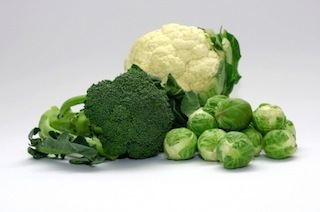 You could be having a fairly routine conversation about health and nutrition where everything discussed is familiar. You hear things like “carbs” and “medium chain triglycerides” and “fructose” and “macros” and “gluten” and “PUFAs,” thinking nothing of it. Like I said, routine. Then someone mentions FODMAPs. Huh? What the heck is that? Quite possibly one of the strangest, seemingly contrived acronyms in existence, FODMAPs represents a collection of foods to which a surprisingly large number of people are highly sensitive. To them, paying attention to the FODMAPs in their diets is very real and very serious if they hope to avoid debilitating, embarrassing, and painful digestive issues.
You could be having a fairly routine conversation about health and nutrition where everything discussed is familiar. You hear things like “carbs” and “medium chain triglycerides” and “fructose” and “macros” and “gluten” and “PUFAs,” thinking nothing of it. Like I said, routine. Then someone mentions FODMAPs. Huh? What the heck is that? Quite possibly one of the strangest, seemingly contrived acronyms in existence, FODMAPs represents a collection of foods to which a surprisingly large number of people are highly sensitive. To them, paying attention to the FODMAPs in their diets is very real and very serious if they hope to avoid debilitating, embarrassing, and painful digestive issues.
To begin, what exactly are FODMAPs?
As I said, it’s an acronym:
F is for Fermentable - Fermentable carbohydrates are carbohydrates that are fermented by bacteria instead of broken down by our digestive enzymes. In most people, some fermentable carbohydrates are healthy sources of food for the (helpful) bacteria that ferment them; these can include the prebiotics I’ve championed in the past and can actually improve digestive and overall health. In people with FODMAPs intolerance, certain carbohydrates can become too fermentable, resulting in gas, bloating, pain, and poor digestion, as well as proliferation of unwanted pathogenic bacteria.
O is for Oligosaccharides - Oligosaccharides are short-chain carbohydrates, including fructans (fructooligosaccharides, or FOS, and inulin) and galactans (raffinose and stachyose). Fructans are chains of fructose with a glucose molecule at the end; galactans are chains of galactose with a fructose molecule.
D is for Disaccharides - These are pairs of sugar molecules, with the most problematic being the milk sugar lactose (a galactose molecule with a glucose molecule).
M is for Monosaccharides - This describes a single sugar molecule. Free fructose is the monosaccharide to watch out for with FODMAPs intolerance.
A is for And - Every list needs a good conjunction.
P is for Polyols - Polyols include sugar alcohols like xylitol, sorbitol, or maltitol. For an idea as to their effects, type one of them into Google and note the autofill choice (hint: it’s usually “diarrhea” or “constipation” or “gas”). Since large amounts of polyols rarely occur in nature, lots of people have trouble with them.
Most people probably don’t need to worry about these categories. Most people enjoy pristine, effortless trips to the toilet that happen like clockwork and finish in under a minute. Heck, as I understand it, most people don’t even use toilet paper these days; they are that efficient and clean. Yes, it’s true: digestion worldwide has never been better!
The reality, of course, is that digestive difficulties are widespread, particularly in the industrialized world. If it’s not constipation, it’s diarrhea. Or bloating. Or gas. Or hemorrhoids. Or IBS. Or all of the above. These complaints are sadly very common (even more common than those stats would suggest, since many people are too embarrassed to admit they have an issue). For many of these people, FODMAPs may be exacerbating their symptoms.
Normal carbohydrate digestion takes place in the small intestine, where polysaccharides are broken up into glucose, fructose, and galactose and transporters like GLUT2 and GLUT5 absorb them for the body to use as nutrients. Sometimes those sugar molecules make it past the small intestine into the large intestine where colonic bacteria – the gut flora we (sorta) know and love – gobbles it up via fermentation, potentially causing gas and painful bloating. The presence of too many sugars in the colon can also cause an influx of fluid, which could lead to diarrhea. Constipation is another common symptom, though it’s not clear exactly how FODMAPs cause it. And some polysaccharides, like the oligosaccharides, make it through to the colonic bacteria as a rule because they resist digestion in everyone (in healthy people, these have a useful prebiotic effect).
You might be thinking, “Cool, so I can just avoid those weird sounding sugars and be fine, right?” Probably not. FODMAPs are very prevalent in the food supply. Even if you avoid free fructose, don’t drink milk, and ditch processed food containing sugar alcohols, you’ll still run into them in many fruits and vegetables.
FODMAP-containing vegetables include:
Asparagus (fructose, fructans), artichoke (fructose), beets (fructans), broccoli (fructans), Brussels sprouts (fructans), butternut squash (fructans), cabbage (fructans), celery (polyols), cauliflower (polyols), eggplant, fennel (fructans), garlic (fructans), leek (fructans), mushroom (polyol), okra (fructans), onion (fructans), shallots (fructans), sweet corn (fructose), radicchio (fructans), sweet potato (polyol)
FODMAP-containing fruits:
Apples (fructose, polyol), apricots (polyol), avocados (polyol), blackberries (polyol), cherries (fructose, polyol), plums (polyol), pluots (polyol), lychees (polyol), nectarines (polyol), peaches (polyol), pears (fructose, polyol), persimmons (polyol), grapes (fructose), mango (fructose), watermelon (polyol, fructose), dried fruit (fructose), juice (fructose)
Plus sweeteners like honey, agave nectar, maltitol, sorbitol, mannitol, and xylitol. And any dairy that contains significant amounts of lactose, like milk or soft cheeses. Depending on your sensitivity, cream or butter can even do the trick.
So it covers quite a few otherwise healthy Primal foods (and some non-Primal ones, like wheat and rye and the aforementioned refined sweeteners).
Let me reiterate before I go on, because I don’t want to scare everyone away from berries and broccoli: not everyone has problems with FODMAPs. Most people probably don’t. If you’re eating all that stuff without issue, continue doing so and consider this post merely an academic curiosity.
Who might benefit from limiting FODMAPs?
Anyone with small intestinal bacterial overgrowth (SIBO).
Normally, the small intestine has relatively low numbers of gut flora residents. In SIBO, it’s got tons that aren’t supposed to be there. They interfere with nutrient absorption, digestion, and just generally muck everything up. SIBO has been shown to correlate quite strongly with lactase deficiency. Without enough lactase, you won’t be able to digest lactose (one of the premier FODMAPs) and your colonic bacteria will have to do the job. Another, earlier study found that patients with SIBO also show malabsorption of fructose and sorbitol in addition to lactose; all three are FODMAPs.
Anyone with IBS.
Low-FODMAP diets beat the pants off conventional dietary advice for people with IBS. One study found that while healthy subjects had increased flatulence on a high-FODMAP diet, subjects with IBS had increased flatulence in addition to lethargy and adverse GI symptoms. This could indicate that both groups were feeding FODMAPs to their gut bugs (which produce the flatulence through fermentation), but only the IBS patients had enough pathogenic gut flora to produce adverse symptoms.
Anyone suffering from chronic stress.
Stress is a well-known disruptor of digestive function as anyone who’s gotten queasy, lost their appetite, or had explosive diarrhea before the big interview could tell you. There’s evidence that stress might be causing FODMAP-intolerance, too. First, stress inhibits the action of GLUT2, a transporter responsible for the small intestinal absorption of glucose, fructose, and galactose in the gut. If you’re unable to adequately absorb the sugar molecules in the small intestine, they end up making it to your large intestine for fermentation by colonic bacteria. Second, stress has an immediate impact on the composition and function of your gut flora, rendering your populations less diverse and allowing certain pathogenic species to overpopulate.
Anyone with otherwise unexplained digestive problems.
Maybe you haven’t had a diagnosis. Maybe you just don’t feel right after eating almost anything. Maybe you’re chronically constipated (or the opposite). Trying a low-FODMAP diet can help you narrow your focus and start to identify some culprits.
If you decide to embark on a low-FODMAP diet, consider keeping a diet journal to log your food and track your reactions to individual FODMAPs. Some people might really react poorly to fructose while having no issues with lactose. Point being: different FODMAPs affect different people differently. You can tolerate some and not others.
Dosage matters, too. A gram of inulin might be fine, while five grams could cause distress. Individual tolerance must be determined by, well, seeing what and how much you tolerate.
If you’re interested in healing your gut, whether from SIBO or IBS or anything else that might be predisposing you to FODMAP intolerance, well-established protocol like GAPS (Gut and Psychology Syndrome) diet or SCD (specific carbohydrate diet) may help and are worth looking into.
If you have no digestive issues, I would caution against trying a low-FODMAP diet “just because.” You’ll be missing out on some very nutritious, important foods, probably unnecessarily, while adding a bunch of unnecessary stress to your eating. FODMAP-related digestive issues are very noticeable. You’ll know it if you have it.
Well, that about sums it up. I hope this basic Primal Primer was helpful for you.
Now that we’re done, what about you? Do you have any sensitivities to FODMAPs? Has looking at that list of FODMAP foods made lightbulbs go off? Let me know below!
Order The Primal Blueprint Starter Kit and Take Control of Your Health Today!

October 28, 2013
Dear Mark: Conditioning Bare Feet for Rough Surfaces, and Residual Weight Gain After a Miscarriage
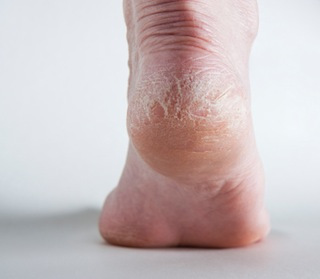 For today’s edition of Dear Mark, I answer two good questions from readers. First up, I discuss the conditioning of bare feet for the purposes of walking across a multitude of surfaces. Believe it or not, much of the conditioning happens upstairs – in the brain. Then I give a little advice to a woman who’s having trouble losing stubborn weight after a miscarriage. She’s doing everything right without getting anywhere; could that actually be the problem?
For today’s edition of Dear Mark, I answer two good questions from readers. First up, I discuss the conditioning of bare feet for the purposes of walking across a multitude of surfaces. Believe it or not, much of the conditioning happens upstairs – in the brain. Then I give a little advice to a woman who’s having trouble losing stubborn weight after a miscarriage. She’s doing everything right without getting anywhere; could that actually be the problem?
Let’s go:
I recently started really conditioning the bottoms of my feet. I am interested in the lower leg-strength benefits, as well as ‘blister-proofing’ my feet for better performance in sporting events.
My question is, how long until it stops hurting to walk across surfaces such as gravel? Also, any tips for conditioning the bottom of the arch? The pads are toughening up nicely, but the arch lags far behind (I do not have high arches).
Thanks!
Adam
A few tips:
Avoid excessive callouses. Experienced barefooters talk about turning the bottom of the feet into supple leather, not hardened callous. You want to feel the ground to facilitate the boost in proprioceptive awareness between mind, body, and environment offered by barefooting.
Step straight down. Don’t slide your foot along the surface. Don’t drag your feet. Don’t stub your toe. Place your foot down. Any rough, abrasive surfaces or protruding sharp objects you encounter will be a lot less bothersome if you’re coming straight down on them, rather than dragging your soles across.
Step lightly. Ideally, you’ll be taking shorter, lighter steps when barefoot. This reduces the weight of your footfall, which has two benefits. You’re not coming down so hard, so it’s less painful when you step on gravel. You’re also not committing so much to your step when you take a short one, allowing you to respond to an inhospitable surface more quickly and remove your foot from the situation.
Change your perception of “pain.” Pain hurts, yes. That’s the point of it – to keep us out of harm’s way. But I think the key to barefooting over any surface is the remodeling of how we perceive pain. And the pain of walking over rocks or gravel with bare feet is just the shock of a sheltered foot suddenly thrust into a new situation. The “pain” doesn’t ever really go away. You don’t stop feeling the gravel bits. You do, however, start thinking of the pain as information. Data for a fuller picture of the environment. After that, it stops hurting so much.
Hope it helps! Keep at it!
Dear Mark,
I am hoping that you can help me! Four years ago, Primal Blueprint changed my life. I have been living primally ever since I finished your book. I initially lost about 25 pounds and I have kept the weight off. Over the past two years, I have gradually lost weight, maybe about 10 pounds or so. I have experienced plateaus before but have pushed through them and continued to effortlessly lose weight.
I got married a few months ago and the ladies at the alterations place were getting a little irritated with me because every time I came in for a fitting, they had to keep sizing down my dress!
I also recently experienced an early miscarriage, the doctor said it was due to a chromosomal irregularity so my body rejected the pregnancy. I had packed on 10 pounds up until the miscarriage. Now I am finding it next to impossible to lose the weight. Because I was experiencing such difficulties, I have really been vigilant regarding my carb intake. I have eliminated dairy completely (no more full fat raw cheese snacks for me!). I also eliminated fruits and just allow myself to have some berries for a snack or dessert occasionally. I’m exercising more than I have in the past: walking two miles in the mornings, biking four miles in the evening and lifting heavy things three times a week. So I don’t understand why the weight isn’t melting away as it has done so easily and consistently before. I’ve really just been eating high quality grassfed meat, wild caught local fish, pastured eggs, pastured bacon that my husband and I have cured ourselves, organic vegetables and organic berries.
I even went back to the doctor to have my hormone levels checked along with a complete blood panel and everything came back perfect!
If you can shed any light on this, I would really appreciate it!!
Thanks in advance, Mark!
Maria
In your case, I’m actually going to suggest that you ease up on everything. The diet, the carb and cheese elimination, the berry fears, the increased exercise, the micromanagement of your lifestyle, all that.
I know lots of women who have had a miscarriage, and almost without exception they’ve all experienced residual, nagging, stubborn weight gain in the months after. And growing more and more strict with the diet and exercise doesn’t really seem to work. In fact, it’s actually counterproductive (which, I think, is what you’re experiencing). The more you fine tune, the more stubborn the fat becomes. It may not be your food that’s the issue. Rather, it may be your mindset. You’ve gone through what can be a pretty traumatic experience, and you certainly don’t need any more stress in your life at this time.
Take full advantage of the 80/20 rule. Ease up on the diet. Stick to Primal fare, but eat the things that you’ve been consciously eliminating, like berries and even other fruit.
Eat that full-fat cheese. Besides, a recent study just confirmed that people with the highest blood levels of certain dairy-related phospholipids and fatty acids are the most insulin sensitive. That’s right: eating full-fat dairy likely increases your insulin sensitivity and carb tolerance.
Exercise: Stick with the walks, but don’t force yourself to do them. If you honestly feel like walking, then walk. If you’re lagging one morning and feel like snuggling up under a blanket with some tea, skip the walk and go with the blanket.
I’d ditch the bike rides, unless they are truly leisurely and meandering. No hard bike sprints, no uphill climbs where you’re gripping the handle bars til your knuckles run white and your jaw muscles clench.
Lift twice a week. And opt for heavier weights, lower reps. Less volume overall.
Try to replace two or three of your workouts with play bouts, or playouts (as Darryl Edwards would say). If you’re out of ideas, try some of these on for size.
Try all (or some of) this for a few weeks and see if things start moving in the right direction. Be sure to write back if you need anything else. Good luck! It’ll get better, I promise!
That’s it for today, folks. Thanks for reading and keep the questions coming!
Order The Primal Blueprint Starter Kit and Take Control of Your Health Today!

October 27, 2013
Weekend Link Love
 Hey guys, let’s try something cool. If you use Twitter, send a tweet to @TomHanks on my (@Mark_Sisson) behalf. I think we can help the dude beat type 2 diabetes if he agrees to give it a go.
Hey guys, let’s try something cool. If you use Twitter, send a tweet to @TomHanks on my (@Mark_Sisson) behalf. I think we can help the dude beat type 2 diabetes if he agrees to give it a go.
Research of the Week
Is the endowment effect a universal human trait, as many claim? Apparently not. Hadza Bushmen living near major roads who participate in the tourism trade have it, while otherwise culturally and genetically identical Hadza Bushmen who have no contact with tourism do not. It may be that the endowment effect arises from market-driven societies.
When we sleep, the brain clears out the toxins that accumulate during the day.
Interesting Blog Posts
Professor Tim Noakes shows how a rigorous $700 million trial proved that “heart-healthy” low-fat diet interventions worsened the prognosis in heart disease and diabetes. Whoops.
Media, Schmedia
I was recently named one of the top ten “social healthmakers” in nutrition. I’m honored.
After reading this Business Insider piece, I think I can pack it up here. My job is pretty much done.
“Saturated fat is not the major issue,” breathed the dreamy doctor, staring through you. It was a tough read, that gaze, and meeting it required physical exertion. Was it cocksure? Photo-shoot fatigue? A hint of disgust cast the way of CW? His right eye painted a different picture than his left. (Hat tip to Dr. Ronesh Sinha, fresh off highly regarded PrimalCon Tahoe presentations and now hard at work completing his book, The South Asian Health Solution, who sent me the link.)
Everything Else
Featuring my good friends Dr. Michael Eades and Dr. Jonny Bowden, this video from Oz really explains how the lipid hypothesis has misled us for so long.
It seems there’s a “paleo bakery” in the Netherlands. Sounds interesting. Any locals want to check it out and give us a report?
Sam Feltham ate a low-carb, high-fat hypercaloric diet and got leaner; he gained weight and lost inches off his waist. Then, he ate a high-carb hypercaloric diet and got fatter; he gained weight and inches. It’s a cool experiment that shows calorie counts don’t tell the whole story.
Ancestral diets are hurting the bread industry. Not a lot, but still.
How one woman went from “I will NEVER go paleo” to “I tried the paleo diet and I’m never turning back.” Seen it a thousand times.
And finally, is this pic relevant to Primal living? No, not really (“something something Inuit”). But it’s incredibly cute, so I’m leaving it.
Recipe Corner
Autumn is upon us, and that means it’s time for lots and lots of soups. Why, here’s one now.
What better combination of words is there than “lamb” and “crusted”?
Time Capsule
One year ago (Oct 27 – Nov 2)
9 Ways Your May Be Inadvertently Sabotaging Your Weight Loss Efforts – Sometimes we’re our own worst enemies. Here’s how to spot the signs.
How to Survive a Natural Disaster – No, it’s not food, or water, or ammunition; what you really need to survive are people around you on whom you can rely.
Comment of the Week
“I’m thinking we set up a drum circle for the next PrimalCon. What do you think?”
How come no one ever suggests setting up a brass band for these types of things?
Yeah, or how about an ululation party?
- Hey, if you guys provide the brass and rapidly moving uvulas, it’s all good!
Get Your Omega-3s: Order Two Bottles of Primal Blueprint Fish Oil Capsules and Get An Additional Bottle Absolutely FREE

October 26, 2013
Homemade Deli Meat
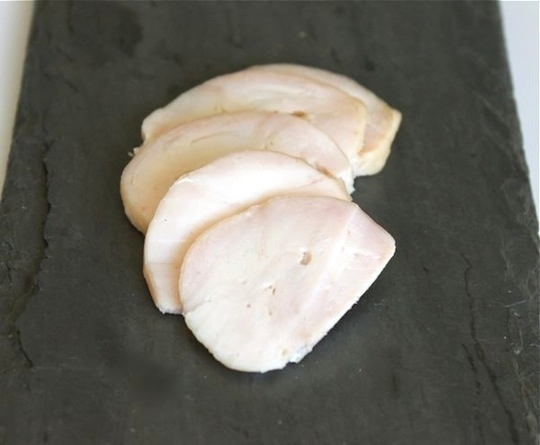 The popularity of deli meat can’t be explained by convenience alone. There’s something about the smooth, supple texture and salty, slightly sweet flavor that some people love. If you’re one of those people, homemade deli meat could become your new favorite snack or salad topper.
The popularity of deli meat can’t be explained by convenience alone. There’s something about the smooth, supple texture and salty, slightly sweet flavor that some people love. If you’re one of those people, homemade deli meat could become your new favorite snack or salad topper.
It turns out that meat of questionable origin, half a dozen unrecognizable ingredients and preservatives and loads of salt and sugar aren’t necessary to make deli meat. All that you really need is chicken (or turkey) breast, a sprinkle of salt and a drizzle of pure maple syrup.
This recipe requires time (most of it hands-off) but very little effort. Cover the meat with a little syrup and salt, refrigerate 48 hours, bake low (250 ºF) and slow then chill before slicing. What emerges is a chicken breast transformed into a smoother, suppler version of its regular self. The meat has the same sweet and salty flavor of store-bought deli meat; it’s delicious sliced thinly for snacking or cut into thick squares for a salad.
Servings: 4
Time in the Kitchen: 2 1/2 hours, plus 48 hours to brine
Ingredients:

2 boneless, skinless chicken breasts (or approx. 1 pound of total meat) (450 g)
4 teaspoons pure maple syrup (20 ml)
1 tablespoon kosher salt (15 ml)
1 tablespoon dried herbs or spices (optional) (15 ml)
Instructions:
Put the syrup, salt and any seasonings that you like in a sealable plastic bag.

Add the chicken breasts and rub the syrup and salt into the meat. Release as much air as possible, seal the bag and refrigerate for 48 hours, turning the chicken breasts occasionally.
Rinse the chicken off with water then soak in a bowl of cold water for 1 hour. This removes excessive saltiness.
Preheat the oven to 250 ºF (120 ºC)
Pat the chicken dry.
Pound the breasts into thin even slabs. Roll each slab up and tie it with twine. (Pounding and rolling the meat isn’t entirely necessary but it helps the meat cook evenly and allows you to slice the meat in even rounds after it’s cooked.)
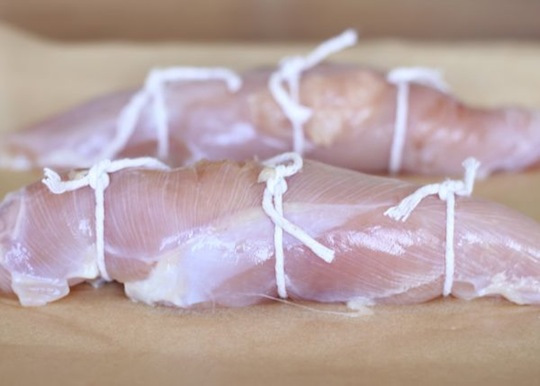
Place the rolled breasts on a parchment lined or well-oiled baking pan.
Bake for 1 hour or until the meat temperature is 165 ºF. (74 ºC)
Remove the twine and let the meat cool completely in the refrigerator before slicing.
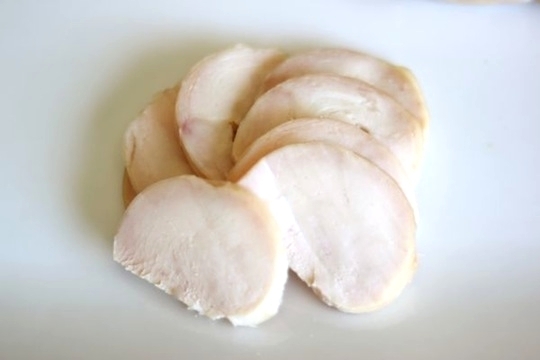
Not Sure What to Eat? Get the Primal Blueprint Meal Plan for Shopping Lists and Recipes Delivered Directly to Your Inbox Each Week

Mark Sisson's Blog
- Mark Sisson's profile
- 199 followers




